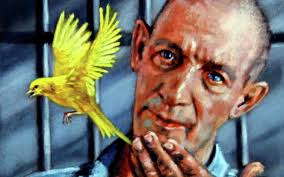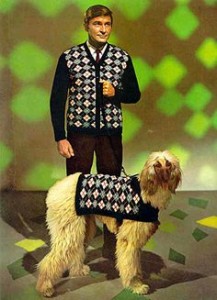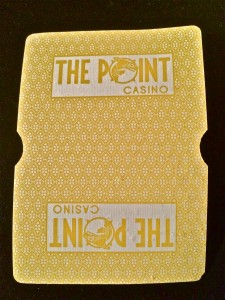I used to send my mother a Father’s Day card when I was in my 20s. I was between fathers at the time. And though the notion that Mama Tried implies that Mama failed– a greeting card seemed appropriate. It was.
Mom didn’t fail to be as good a father to me as she could. But she was pretty busy also being my mother, so it couldn’t have been easy. Single-parenting in the 1960s, can you imagine? There were no apps for that kind of thing.
What mom failed at historically was picking husbands. Some of those men were perfectly fathery figures to me, and in fact one of them was my actual father. But their primary roles should have been being mom’s husband, and in these roles they fell short of the household expectations. Huh.
My father father was not ‘cut out’ for the domestic life, something that might have been obvious to anyone other than a glamour-blind girl in her early 20s discovering the intoxicating nocturnal playground of North Beach in the late 1950s. Danny Braimes was ten years her senior, and one hell of a bartender in a golden age of pouring. They both wore white in their wedding at the Presidio, then drove to Ensenada back when you could still just do stuff like that. I was born 18 months later. By the time my sister arrived two years after that Daddy was well out of there.
To be fair, he came back one weekend a month to pick us up and take us to the zoo or museum or to the Sizzler. I don’t remember if it was every month, but mom never bitched about him being a deadbeat or anything. It doesn’t mean he wasn’t one, it’s just that mom didn’t want us to suspect as much, which is the highest possible road available to any single parent.
I didn’t know him well. I was just a kid and he was one of those strong mid-century men who probably didn’t know what to say to kids. We went fishing. And although we never went hunting, we did go shooting. Once on an overnight at Lake Berryessa I hit a couple of tin cans in a row with the Ruger Mark II, and Daddy said if hit one more I could have the gun. Like a lot of things, he probably hadn’t really thought this through, and he must have been pretty relieved when I missed the next can, because dropping me off on Sunday night with a handgun wouldn’t have set well with mom and I don’t think he’d have bothered welching on his deal with me. I can still smell the sweet underbrush & olive trees of the Napa woods, the acrid garnish of gunpowder floating on top. In the modern era, of course, the boy would have been given an open-ended series of second chances sufficient to knock the can off the stump and claim the prize. But this was the early 1970s, and instead my father just shrugged and zipped the pistol back in its holster, lighting a Marlboro.
I called him Daddy and still refer to him as such. Little kids often call their fathers Daddy, and if the relationship doesn’t mature, neither does the tag. I don’t know what his other offspring referred to him as. There were others after and maybe before me, but I believe my relationship with him was more developed than any of the others, such as it was. Just lucky I guess! I was in college when he died, sick & alone at a group home for the sick & alone outside Santa Rosa. By that time I already had a second ex-father.
Mom met Bill Murray (not that one) in 1975 and, after a year’s vetting, married him at the Mormon church on Ludeman Lane in San Bruno. I wore a green tuxedo like the rest of the males in the wedding party and I gave mom away. There was a reception in Aunt Susie’s backyard on Linden Avenue afterward with foamy champagne punch. From this vantage, Bill looked like a good fit– father and husband-wise. But springtime perspectives can be deceiving. After uprooting and migrating to someplace called Federal Way, Washington, it was learned that Bill and mom were not all that compatible after all. They divorced in 1983 after a couple of painful separations. Bill wasn’t great with money.
He was a very good “father” however. He coached my sports teams. He took me to see Maynard Ferguson. He told me he loved me. He did love me, and I loved him, too! Though there was never any talk of legal “adoption,” I did eventually begin to call him Dad. Not Daddy, just Dad. Bill was 6’4” and probably ran 230lbs in those days. He was terribly handsome with a flap of skin that drooped over the outside corner of his left eye which made him look like he was always listening to you very intently. After the divorce, I didn’t see him much, and when I did I called him Bill. I left for college.
Bill gave me my sex talk in August 1977, when I was still calling him Dad. He used the tits on my Farrah Fawcett poster to make his point(s) that to be interested in TV stars’ tits was perfectly natural. I didn’t really learn much about sex during the conversation, but did come away with a vague sense of relief that the furious masturbating I was doing in the direction of that poster was a dance every boy on the block was doing and that it was OK with Dad (Bill) and my Mom.
Bill liked big band jazz and would have a scotch & water with mom when he got home from work, but I don’t think usually more than one or a short two. He usually had a Kent between the massive fingers of his left hand, though—he was the first left-handed person I ever knew, or at least the first left-handed person I ever knew was left-handed. The last time I ever saw him was at my wedding, which was kind of weird because my next “father” was there, too.
Mom met Art Bender in the early 90s at a piano bar on Brown’s Point. He’d recently separated from his wife– the mother of his two biological and three adopted children– and was taking what seems in retrospect like a well-deserved breather. What he was doing in a piano bar in Northeast Tacoma I’ll never know. He couldn’t hear or sing a lick, even then. But there he was…
Mom introduced us not long after. By a cruel twist of scheduling fate it happened to be Father’s Day weekend, which was awkward for everyone since no one present was the father of anyone else present. I might actually have realized sooner than Art that I would soon be referring to him as my mother’s husband (not really my father). In any event, he divorced his wife soon after and married my mother on Independence Day 1992 in Aunt Susie’s backyard, this time in Reno. I sang “The Rose” at the bridal party’s request and then we all went downtown to play cards and get wasted.
Unlike Mom’s first two husbands, Art liked to drink. He could drink a bathtub full of bourbon and often did. I never observed it affecting him, and I don’t think it bothered Mom at first either. Eventually, however, pretty much everything Art did bothered Mom. They drove to Arkansas after the wedding and stayed there for about five years before Art was offered a transfer back to Federal Way. He took it so they could both be nearer their grown children (ahem) and they bought the house on Steel Lake in 1996. They proceeded to wait patiently for grandchildren which arrived presently in the form of mine and my sister’s kids. Mom died in the house on the lake 15 years later, married but not what you’d call happily.
That morning Art stood crying in the hallway outside the bedroom as the undertaker and his assistant zipped my Mother’s body into a black vinyl bag. Art wasn’t much of a cryer or a revealer of much any emotion, which was one of the things that had driven my Mom crazy while she was still alive. I’d only ever seen him cry once before, on the night of his adopted daughter’s death. It was as if he saved up all his emotion in between these momentous events and all the accumulated tears sprayed out like in a cartoon.
Art is an old widower now, living quite contentedly with hundreds of channels. We see him regularly, the only grandfather my kids have ever known, though he is not my father. I call him Art, always have. My sister used to sometimes call him “Pops” but I think that was mostly for Mom’s benefit. Now she mostly just calls him Art also. He’s a very good person. He was always good to Mom and he’s always been good to me and my family. Like a father you might say.
My mother was like a father to me, too, for much of my life. She always tried to do what was best for everyone, not just for herself. Whether being more selfish would have worked out better for everyone is hard to say from here. She tried, though—and in the end that’s all anyone can ask.
Happy Father’s Day, Mom…
How many peeves are we allowed to keep as pets before they’re just peeves? And what’s the difference, anyway? Do Pet Peeves get to sleep on the bed with us while the general population shivers outside or in the garage? Are some peeves domesticated and others feral?
Pets of any variety are comforting. They love us unconditionally and are generally free of the bullshit hang-ups that render the relationships with our upright companions so frequently intolerable. Whether we keep dogs or cats or snakes or goats, many of us are more invested in our pets than we are in the seemingly more primary relationships in our lives including the ones we flog with our spouses, children and parents.
But where is the line? How much is too much—how many too many?
Every neighborhood has a “crazy cat lady.” No one visits her because her furniture & cutlery is coated in a film of silky dander and the whole place smells hard of piss. Cat lady’s house is usually too warm inside. The mewing is unnerving.
Robert Stroud was known as the Birdman of Alcatraz, despite the fact that he was not allowed to keep birds on The Rock. And although he did raise  hundreds of canaries and author several well-respected books on Orthonology during a prior sentence at Leavenworth, the dude was evil & insane. A poor model.
hundreds of canaries and author several well-respected books on Orthonology during a prior sentence at Leavenworth, the dude was evil & insane. A poor model.
Plenty of dog owners not only dress their best friends in garish sweaters & hats, but often don complimentary or even matching outfits themselves. This is not OK. Not OK.
 So who is to say how many peeves I can reasonably keep as pets? Is the peeve police going to come to my door? Are my neighbors going to turn me in? Should I be more careful about the kind of loose assertions I make on social media?
So who is to say how many peeves I can reasonably keep as pets? Is the peeve police going to come to my door? Are my neighbors going to turn me in? Should I be more careful about the kind of loose assertions I make on social media?
I don’t much give a damn. We’ve all got our hangups, and sometimes it feels good to vent. So whether I have room in the kennel for all these peeves or not, I’m not sure. But here are a few of my favorite peeves, otherwise known as the kind of shit that just drives me crazy.
That’s about it. Pretty much everything else is fine with me.
If you see a penny on the sidewalk, look around a bit and you’ll usually find another one plus a dime, too. Same goes for playing cards. People don’t generally drop just one playing card.
And when you’re two cards away from completing the deck of found playing cards you’ve been building since the 1980s, you learn to draw wisely. Fairly, but wisely.
If there’s only one card on the ground, of course I’ll pick it up. But if there’s more than one, odds are half of them will be face-down. And those are the ones from which I choose. It’s fair– Even Steven!
I don’t know what two cards I need to complete the deck. I know I’m suited in hearts, but I’m not positive about diamonds. I actually think the two cards I need are black suits, but I’ve been very careful not to know for certain because if I ever saw the card I knew I needed in a face-up scatter on the sidewalk I’d be in a real moral jam. It would be hard not to pick it up– and I’d like the deck to be completed as organically as possible. I don’t want to get any hassle from the Ripley’s people once I’m done.
I happened on a hand last night on Cornwall. It was New Year’s Eve and the gang outside Downtown Johnny’s was smoking tough at 9pm. I first spotted a red-suited facecard in the gutter, and I jerked spastically in my tracks like I always do when I see a playing card on the ground. Glancing around to make sure no one else was closing on it, I scanned the vicinity for more options and was not disappointed. In the middle of the sidewalk at the north end of RiteAid were two cards, face down.
Glancing around again, I nonchalantly approached the cards, crouching down to study the backs. A pale yellow vector design advertising someplace called the Point Casino stared back at me. There’s not much technique in choosing  a face-down card. Pick a card, either card. I’m right-handed, so I picked up the card on the left and stuffed it in my pocket. Then I went to Akroteri for a glass of Ouzo.
a face-down card. Pick a card, either card. I’m right-handed, so I picked up the card on the left and stuffed it in my pocket. Then I went to Akroteri for a glass of Ouzo.
I need two cards to complete my deck. Of course I’m going to draw lots of doubles before I find these last two cards. The King of Diamonds, the Queen of Clubs– I already got em. Hell, I found two Aces of Spades last year alone, but guess what– I already got one!
But you know what else I already got? Jokers. I already got tons of jokers.
And there’s only two of them in a deck. Aren’t the odds the same of me finding one of the two cards I need the same as finding another joker?!
I collect stuff, always have. I come from a long line of lovers of stuff: pottery, cufflinks, Foo Dogs, Fiestaware—if it’s collectable, an ancestor of mine probably hoarded it. I most certainly have what Bob Ridgley & Terri Krantz referred to in their 2008 documentary American Collectors as “the collector’s gene”—an uncontrollable (or at least uncontrolled) urge to gather quantities of the same thing up in piles. Some collections are made to stack, like records or plates. Others—like tractors or cadavers—aren’t as easy.
Patti thinks I have a problem. Matchbooks, inkwells, KISS memorabilia and brass bug silent butlers are bad enough. But when I realized I was actually clipping the corrections out of the daily paper and putting them into an envelope labeled CORRECTION COLLECTION, I realized that maybe it was time I got some help.
The dark danger with most collections is that they’re open-ended: they can never be completed. You just keep on adding and adding– presumably until you die– at which point your kids have to come in and agonize over what to do with Dad’s prized collection autographed 8×10 black & white promotional photos of bald celebrities.
But I do have one collection that doesn’t take up much space, is easy to stack, and which has a definite end. Part of me hopes I never complete it…
It’s the same thing every season. This region prefers football to baseball, and I can’t say I don’t understand why. Most people don’t have the patience for baseball in our one-minute culture. And the fact that there were no professional sports of any kind in the PNW before the 1970s means collegiate sports (where there is no baseball) have a deep comparative history. But it’s frustrating that the most exciting part of a long baseball season (the stretch and post-season) coincides with the beginning of the football campaign, and that this preview and early-season period is given such clear preferential broadcast consideration on the local sports radio affiliate. I have this argument with them every October in some form. This was a FaceBook message from 2012